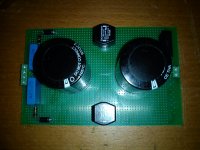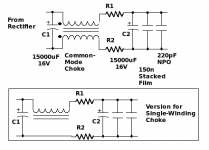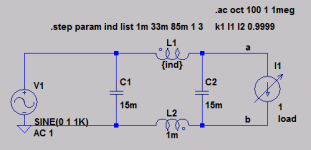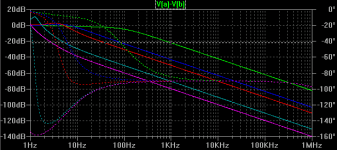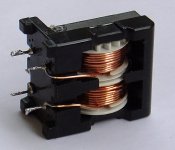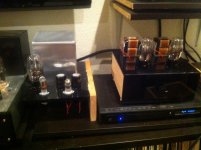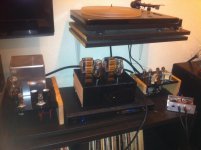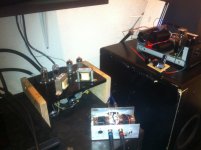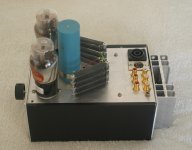I have a doubt, due to the fact chokes are dual 2mH 1.5A, I suppose that I have to connect in parallel to reach 3A, right?
Felipe, they look like common-mode chokes.
Connect them like the top one in this drawing (taken from my application note) ........
...
Attachments
Old crt monitors that people throw out have some nice common mode chokes at the very input of their power supplies. You can also find some in computer SMPSs. Those I've measured to be anywhere from 18mh to 33mH. Have a look what the effect of a few values is: 1mH 33mH 85mH 1H 3H, and this in the ideal world of the simulator. My point is, very little noise attenuation is to be expected from such small value chokes.
Attachments
The old monitors use the CMCs to keep high frequency noise from getting OUT of the monitor (for emissions test limits).
In DHT filament supplies, the goal is to keep the mains-carried HF from getting IN.
And it is important to keep HF/VHF/UHF from getting in, since it's hard to predict what effects it will have. Most HF noise is AM or FM modulated, or more likely, both together.
HF noise can couple right through your signal chain, even backwards from the preamp DHT to your RIAA or DAC signal stages. If it gets this far, the risk of demodulation, and audio noise is very high.
In DHT filament supplies, the goal is to keep the mains-carried HF from getting IN.
And it is important to keep HF/VHF/UHF from getting in, since it's hard to predict what effects it will have. Most HF noise is AM or FM modulated, or more likely, both together.
HF noise can couple right through your signal chain, even backwards from the preamp DHT to your RIAA or DAC signal stages. If it gets this far, the risk of demodulation, and audio noise is very high.
The old monitors use the CMCs to keep high frequency noise from getting OUT of the monitor (for emissions test limits).
In DHT filament supplies, the goal is to keep the mains-carried HF from getting IN.
Chokes are not directional, keeping the noise in isn't any different than keeping the noise out. Since they're easy to come by, you can put as many in series as you want/have. They are intended for high current, so they'd be fine for the dht supply.
Here's a sample of such choke. Two windings, 30mH with a Q of 10 each, physical size of about 28x30mm. Can be used as common mode choke, or with the two windings in series (cross connected); in this case it measured as 100mH with a Q of 24.
So, why bother though. What's the difference between a 1mH choke and a 30mH choke? The 1mH choke in the simulation example above makes the 1kHz noise 12.5 times lower, whereas The 30mH choke makes it 125 times lower.
Disclaimer: I'm not selling old monitors or such chokes. I'm merely saying that such chokes exist and you'll feel good about doing something good for the environment. Most old electronics end up in the landfill.
So, why bother though. What's the difference between a 1mH choke and a 30mH choke? The 1mH choke in the simulation example above makes the 1kHz noise 12.5 times lower, whereas The 30mH choke makes it 125 times lower.
Disclaimer: I'm not selling old monitors or such chokes. I'm merely saying that such chokes exist and you'll feel good about doing something good for the environment. Most old electronics end up in the landfill.
Attachments
That's not bad is it? I'm suprised actually.1kHz noise 12.5 times lower
Yes, but the inductance will 1mH. Not sure what 1mH will accomplish though.
Felipe, they look like common-mode chokes.
Connect them like the top one in this drawing (taken from my application note) ........
...
Thank you guys.
Hey guys, since I' new around here I thought I'd post about some of my opinions on the stages my 26 pre has gone through just for fun, kind of as an introduction. Currently my set up is a PSU with lundahl mains xfmr and lundahl input choke LC stage, followed by a couple RC stages, all mills wirewound resistors and obbligato psu film caps in the psu. This is the best sounding psu I've had so far, I'd like to put in another lundahl choke instead of the resistors but haven't done this yet as right now the amp is DEAD quiet.
Tubes are Wizard branded 26 STs which I believe are RCA manufactured, these are nice sounding, not as nice as the sylvania or tungsols I have but just as good as the rca cunninghams, the wizards are just the closest matched pair so they perform better. Using battery bias with -9V on grids with obbligato gold input cap, I'd like to upgrade the cap soon but as of now this sounds great! I would still like to directly compare to a nice cathode resistor and bypass cap which I initially had but ditched to try LED bias, which I absolutely hated, terrible, so moving to battery bias from this was great.
Currently using Lundahl 1660/PP in 4.5:1 as plate load and output, these are fantastic! Absolutely amazing sounding, much better than my previous hammond 156c + ampohm copper pio output, which I found very hard to beat previously, tried different caps like jupiter beeswax and mundorf silver oils, jensens pios and different nos pios/russian teflons. The ampohms put all of these to shame when it came to sheer musicality and natural timbres I think, not as much "air and detail" as the jupiters or mundorfs but those sounded completely dead and unnatural compared to the ampohms or even obbligato golds, just not worth having the extra detail and air if it means a loss of natural musicality in my opinion. The lundahls, though, were a godsend. Best of both worlds, they retained and even bested the ampohms in naturalness and gave back the spaciousness of the jupiters. Excellent. This was only in 4.5:1 though, I tried them with a closer ratio of 4.5:4 and 4.5:2 but lost a lot of sound quality. I've tried different currents through the lundahls ranging from 4-8mA and settled on somewhere between 6-7mA for the best sound. 5 was good too.
DC filament supply is a simple 6800uF cap followed by LM317 set up for constant current, sounds ok, better than set up for voltage reg but this is all I have tried for filaments so I plan to soon try other methods, including AC heating.. I know everyone tries to dissuade people from doing this for 26s but I'm not convinced until I try, I think I may be able to implement it in a quiet way as I have done before for other sensitive tubes.. I've studied up on this quite a bit in the past, will report back after I try. If this fails I plan to try either Rods regulator or passive LCL filtering with lundahls.
Volume control is a stepped attenuator at input, built by Khozmo. These are the best stepped attenuators I've tried, better than DACT. I put shinkoh tants in the main resistor position which was better than the stock caddock, still haven't tried the nude vishays. I haven't been interested in trying another volume control as these sound so good but Thomas has me curious about the slagle AVCs at output since I'm using the lundahls in 4.5:1.. may try that soon if my wallet allows.
Audiophilia is a curse, I want to try everything :| I have no idea how I've financially managed to try and do the things I do as I don't make nearly enough money to support this addiction being a student. It's been fun though, who needs food when you have great sounding music haha.
BTW my pre is feeding 6c33c monos and self modded magnepan MG12s a la pgunn's method.
Thanks for reading! Open for any suggestions/comments anyone may have.
Tubes are Wizard branded 26 STs which I believe are RCA manufactured, these are nice sounding, not as nice as the sylvania or tungsols I have but just as good as the rca cunninghams, the wizards are just the closest matched pair so they perform better. Using battery bias with -9V on grids with obbligato gold input cap, I'd like to upgrade the cap soon but as of now this sounds great! I would still like to directly compare to a nice cathode resistor and bypass cap which I initially had but ditched to try LED bias, which I absolutely hated, terrible, so moving to battery bias from this was great.
Currently using Lundahl 1660/PP in 4.5:1 as plate load and output, these are fantastic! Absolutely amazing sounding, much better than my previous hammond 156c + ampohm copper pio output, which I found very hard to beat previously, tried different caps like jupiter beeswax and mundorf silver oils, jensens pios and different nos pios/russian teflons. The ampohms put all of these to shame when it came to sheer musicality and natural timbres I think, not as much "air and detail" as the jupiters or mundorfs but those sounded completely dead and unnatural compared to the ampohms or even obbligato golds, just not worth having the extra detail and air if it means a loss of natural musicality in my opinion. The lundahls, though, were a godsend. Best of both worlds, they retained and even bested the ampohms in naturalness and gave back the spaciousness of the jupiters. Excellent. This was only in 4.5:1 though, I tried them with a closer ratio of 4.5:4 and 4.5:2 but lost a lot of sound quality. I've tried different currents through the lundahls ranging from 4-8mA and settled on somewhere between 6-7mA for the best sound. 5 was good too.
DC filament supply is a simple 6800uF cap followed by LM317 set up for constant current, sounds ok, better than set up for voltage reg but this is all I have tried for filaments so I plan to soon try other methods, including AC heating.. I know everyone tries to dissuade people from doing this for 26s but I'm not convinced until I try, I think I may be able to implement it in a quiet way as I have done before for other sensitive tubes.. I've studied up on this quite a bit in the past, will report back after I try. If this fails I plan to try either Rods regulator or passive LCL filtering with lundahls.
Volume control is a stepped attenuator at input, built by Khozmo. These are the best stepped attenuators I've tried, better than DACT. I put shinkoh tants in the main resistor position which was better than the stock caddock, still haven't tried the nude vishays. I haven't been interested in trying another volume control as these sound so good but Thomas has me curious about the slagle AVCs at output since I'm using the lundahls in 4.5:1.. may try that soon if my wallet allows.
Audiophilia is a curse, I want to try everything :| I have no idea how I've financially managed to try and do the things I do as I don't make nearly enough money to support this addiction being a student. It's been fun though, who needs food when you have great sounding music haha.
BTW my pre is feeding 6c33c monos and self modded magnepan MG12s a la pgunn's method.
Thanks for reading! Open for any suggestions/comments anyone may have.
Glad to show! Never posted pics before hope I know how. Heres a few, 26 PSU is on left in the pic, the 0b2 and 12ax7 aren't hooked up, they were for an older design for a series regulated filter that also used 6v6s.. got rid of this circuit due to inferior SQ over passive filtering. Then the 26 signal chassis.. then next to that my phono stage and its psu. The front panels are left off for now due to some recent tweaking. Anyway, here they are..
This was my experience. Without plate chokes (Hammond 156C) I had no problem whatsoever with hum and everything in the same case. With the plate chokes the only way I could get rid of the hum was to move the psu a bit more than 1 meter away.
Same experience I had. Positioning chokes in different angles would help sometimes but issue could not be fully resolved. With CCS, I have everything in one chasis now. Hum is barely noticable through 90 db speakers.
You need a very clean supply for filament bias, and the resistor types are important - should be wire wound and not those crappy white ceramic ones. Needs about 50 watts. I have some, or use multiples of those Welwyn green ones that Farnell etc sell. I use a choke input supply and a Rod Coleman board - the choke makes a difference. Hammond do suitable ones. You need an 18v secondary on the filament transformer.
Attachments
Not willing to generate any kind of debate here, but after successfully building a filament bias 26 preamp with LL1660 OTs and also a low-budget 4P1L filament bias and gyrator loaded pre-amp (which I named "The Siberian") and done a side by side comparison between the two, I have to say that 4P1L is a great match to the 26!:
http://www.diyaudio.com/forums/tubes-valves/190857-4p1l-dht-line-stage-19.html
http://www.diyaudio.com/forums/tubes-valves/190857-4p1l-dht-line-stage-19.html
- Home
- Amplifiers
- Tubes / Valves
- #26 pre amp
